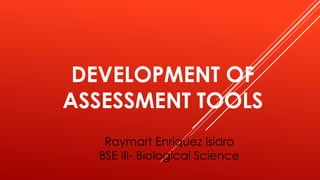
Development of assessment tools
- 1. DEVELOPMENT OF ASSESSMENT TOOLS Raymart Enriquez Isidro BSE III- Biological Science
- 2. Development of Assessment Tools ►Assessment tools in the affective domain, in particular, those which are used to assess attitudes, interest, motivation, and self-efficacy, have been developed. ►There are certain good practices that are considered good practices in developing these instruments.
- 3. STANDARD ASSESSMENT TOOLS IN THE AFFECTIVE DOMAIN
- 4. Self Report ►Is the most common measurement tool in the affective domain. ►It essentially requires an individual to provide an account of his attitude or feelings toward a concept or idea or people. ►Sometimes called “written reflections”.
- 5. Rating Scales ►Set of categories designed to elicit information about a quantitative attribute in social science. ►The basic feature of any rating scale is that it consists of a number of categories. ►These are usually assigned integers. ►Common examples are the Likert scale and 1-10 rating scales for which a person selects the number which is considered to reflect the perceived quality of a product.
- 6. SEMANTIC DIFFERENTIAL SCALES (SD) ►Tries to assess an individual’s reaction to specific words, ideas or concepts in terms of rating on bipolar scales defined with contrasting adjectives at each end. ___ ___ ___ ___ ___ ___ ___ 3 2 1 0 1 2 3 Good Bad The position marked 0 is labeled neutral, the 1 positions are labeled slightly, the 2 positions quite, and the 3 positions extremely.
- 7. SEMANTIC DIFFERENTIAL SCALES (SD) ►The scales actually measures two things: directionality of a reaction (e.g., good versus bad) and also intensity (slightly through extreme). ►Usually, a person is presented with some concept of interest without any other explanatory remarks. ►Ratings are combined in various ways to describe and analyze the person’s feeling.
- 8. SEMANTIC DIFFERENTIAL SCALES (SD) A number of basic considerations are involved in SD methodology: Bipolar adjective scales are a simple, economical means for obtaining data on people’s reaction. Rating on bipolar adjective scales tend to be correlated, and three basic dimensions (Evaluation, Potency, and Activity) of response account for most of the co-variation in ratings.
- 9. Some adjective scales are almost pure measures of the EPA dimensions: for example, god-bad for Evaluation, powerful-powerless for Potency, and fast-slow for Activity - Measurements of a concept on the EPA dimensions are referred to as the concept’s profile. EPA measurements are appropriate when one is interested in affective responses. The SD has been used as a measure of attitude in a wide variety of projects.
- 10. THURSTONE AND LIKERT SCALES THURSTONE is considered the father of attitude measurement. -He addressed the issue of how favorable an individual is with regard to a given issue. -He developed an attitude continuum to determine the position of favorability on the issue.
- 11. Example of a Thurstone scale of measurement (from Thurstone, 1931): Directions: Put a check mark in the blank if you agree with the item. ___1. Blacks should be considered the lowest class of human beings. (scale value= 0.9) ___2. Blacks and whites must be kept apart in all social affairs where they be taken as equals. (scale value= 3.2) ___3. I am not interested in how blacks rate socially. (scale value= 5.4)
- 12. ___4. A refusal to accept blacks is not based on any fact of nature, but on a prejudice which should be overcome. (scale value= 7.9) ___5. I believe that blacks deserve the same social privileges as whites. (10.3) Example of a Thurstone scale of measurement (from Thurstone, 1931):
- 13. In 1932, Likert developed the method of summated ratings (or Likert’s scale), which is still widely used.
- 14. Example of Likert’s scale: Statement: I do not like to solve algebraic equations. Response options: • 1. Strongly Disagree • 2. Disagree • 3. Agree • 4. Strongly Disagree
- 15. It is common to treat the numbers obtained from a rating scale directly as measurements by calculating averages, or more generally any arithmetic operations. In terms of the levels of measurement proposed by S.S. Stevens, the data are ordinal categorizations.
- 16. • In 1944, Guttman suggested that attitude should be measured by multidimensional scales, as opposed to unidimentional scales such as those developed by Thurstone and Likert. • He developed the Scalogram Analysis, Cumulative Scaling, or as usually called, Guttman scalling. The major characteristics of this scale is that the response to one item helps predict the responses to other items. Guttman
- 17. Example of Gutman Scalling For instance, if the individual responds negatively to the item “I like oranges”, he is not likely to respond positively to the item “Oranges are great for breakfast”.
- 18. CHECKLISTS • The most common and perhaps the easiest instrument in the affective domain to construct is the checklist. • A checklist consists of simple items that the student or teacher marks as “absent” or “present”.
- 19. STEPS IN THE CONSTRUCTION OF A CHECKLIST • Enumerate all the attributes and characteristics you wish to observe relative to the concept being measured. For instance, if the concept is “intrapersonal relation”, then you might want to identify those indicators or attributes which constitute an evidence of good interpersonal relation. • Arrange these attributes as a “shopping” list of characteristics. • Ask the students to mark those attributes which are present and to leave blank those which are not.
- 21. ASSESSMENT OF STUDENTS LEARNING 2 SOURCES